







Among the various groups of mosses, Sphagnum is unique in many respects. It has a peculiar structure of having its branches produced in fascicles or two or more diverging branches and two or more pendant (hanging) branches. Near the apex of the plant, these fascicles are compressed together to form a head, or capitulum, giving the moss a tuft-like appearance. The stems themselves show a greater degree of internal complexity than most other mosses. The stem tissue can be divided into two regions, an inner pith (which may be subdivided into two layers) and an outer cortical layer of larger, usually dead cells. The pith is the site of food production and storage, which the cortical layer functions in water absorption and protection.
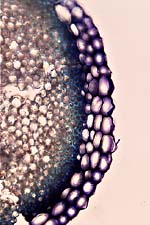 |
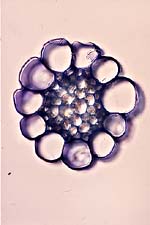 |
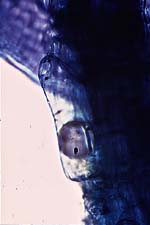 |
Sphagnum stem morphology : The image at left shows a cross section made through the main stem of a peat moss. The large outer cells stained purple are the cortical cells, followed by a dense layer, and then the larger-celled central pith. The second image is of a cross section made through a branch. The final image at right is a close view of a specialized retort cell in the cortical layer of the main stem. Plants are not naturally purple, but were stained for visual contrast.
Located in the cortical layer of many species are retort cells, so named because they resemble the medieval chemical flasks called retorts. These cells are enlarged more than the surrounding cortical tissue, and have a pore, or opening, at one end. These cells are believed to help the moss retain water under intense sunlight, and they often are home to a wide variety of small invertebrates and other microorganisms.
Perhaps the most distinctive feature of peat moss morphology is the leaf. Sphagnum leaves have a unique and unusual arrangement of two different kinds of cells. The most obvious cells are the large hyaline cells, which have thickened bands of supporting material, and often haves pores. These cells are dead at maturity, and serve to retain water. Between the hyaline cells are small slender chlorophyllose cells, so named because they contain the chlorophyll and manufacture food.
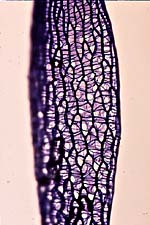 |
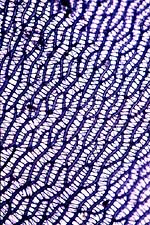 |
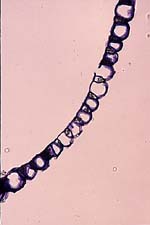 |
Sphagnum leaf morphology : The first image at left shows a species of peat moss in which the large dead cells (hyaline cells) have large pores opening to the leaf exterior. The second leaf has no such pores, but is a closer view showing the two types of cell found in the leaf -- the heavy dark stripes are chlorophyllose cells, while the lighter cells with fainter stripes are the hyaline cells. The final image at right is a section across a leaf, showing again the two kinds of cells and their arrangement. Plants are not naturally purple, but were stained for visual contrast.
Peat mosses are also unusual in the mature plants have no rhizoids for anchoring or nutrient absorption. Their sporophyte has no peristome, but does produce tiny stomata-like structures.


